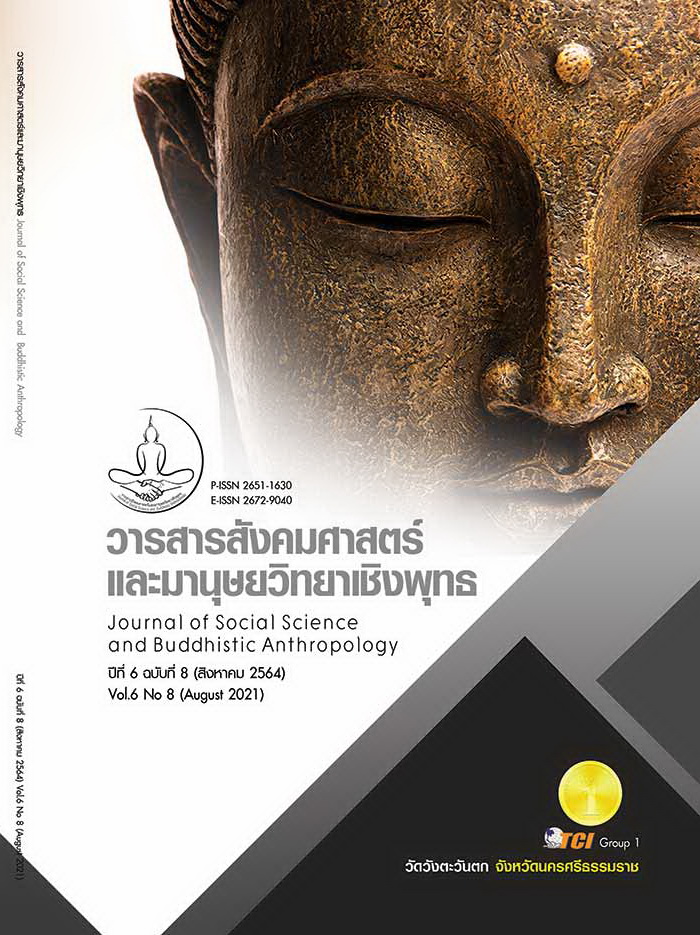GUIDELINES FOR PROMOTING THAILAND TOURISM FOR CHINESE TOURISTS IN THE CHONBURI PROVINCE
Keywords:
Guidelines, Tourism Promotion, Chinese Tourists, ChonburiAbstract
The objectives of this research article were: 1) to study the tourism situation in Thailand from Chinese tourists exploring Chonburi province as a case study and 2) to distill approaches to promote tourism. Samples are 205 Chinese tourists who have traveled in Chonburi province. The research method is a quantitative approach using a questionnaire. Secondary data as well as statistical methods, both Descriptive Statistics and Inference Statistics - Analysis of Variance (ANOVA) and Test of Chi - Square, are used in data analysis. The findings show that the trends regarding the situation of tourism from China and Thailand before the Covid - 19 pandemic were positive, as evidenced by the number of Chinese tourists. The main travelling pattern to Thailand of Chinese tourists is the group package tour. However, the Free Independent Traveler - FIT tourism is another pattern that is highly growing in the tourist market especially for younger age groups. There are concerns over security in case Chinese tourist visas are canceled which could lead to an increase in transnational crime in Thailand and other countries in Southeast Asia. For Chonburi province, the challenges impacting tourism are traffic congestion, convenience and safety. Short - term recommendations are the promotion of safety and standardized tourism as well as providing more tourism information and business available online. In addition, business sectors should develop package tours that are suitable for free Independent travelers. In long - term, governmental sectors should enact and emphasize measures for attracting affluent tourists and improve public transport to cover less visited areas in line with prevention of transnational crime.
References
กระทรวงการท่องเที่ยวและกีฬา. (2562). สถิตินักท่องเที่ยวชาวต่างชาติที่เดินทางเข้าประเทศไทยสถิติด้านการท่องเที่ยว ปี 2561 (Tourism Statistics 2018), กระทรวงการท่องเที่ยวและกีฬา. เรียกใช้เมื่อ 1 มกราคม 2563 จาก https://www.mots. go.th/old/more_news.php?cid=4
ฉัตยาพร เสมอใจ. (2549). การบริหารการตลาด. กรุงเทพมหานคร: ซีเอ็ดยูเคชั่น.
ธีรนุช พูศักดิ์ศรีกิจ. (2537). พฤติกรรมผู้บริโภค. กรุงเทพมหานคร: มหาวิทยาลัยหอการค้าไทย.
ผู้จัดการออนไลน์. (2561). Disruption ท่องเที่ยวจีน มาเองไม่ได้มากับทัวร์แล้ว. ผู้จัดการสุดสัปดาห์, MGR Online. เรียกใช้เมื่อ 6 มกราคม 2563 จาก https://mgronline .com/daily/detail/9610000104399
โพสต์ทูเดย์. (2562). Traxasia ล้วงข้อมูล นนท.จีน เมืองไทยยังอยู่ในใจเสมอ. ข่าวเศรษฐกิจ - ธุรกิจ, โพสต์ทูเดย์. เรียกใช้เมื่อ 1 มกราคม 2563 จาก https://www.posttoday.com/economy/news/602358
สมศักดิ์ หงษ์สุวรรณ และกรวีร์ ชัยอมรไพศาล. (2561). ปัจจัยส่วนประสมทางการตลาดที่มีความสำคัญต่อการตัดสินใจเลือกเรียน สถาบันสอนภาษาต่างประเทศ อัพเกรด อคาเดมี่ จังหวัดเชียงใหม่. วารสารมหาวิทยาลัยพายัพ, 28(1), 151-166.
สาธิต มนัสสุรกุล. (2562). จับ 10 กระแสท่องเที่ยวทั่วโลกในปี 2020. Travel, The MOMENTUM. เรียกใช้เมื่อ 6 มกราคม 2563 จาก https://themomentum .co/travel-trends-2020/.
สำนักงานสภาพัฒนาการเศรษฐกิจและสังคมแห่งชาติ. (2561). ผลิตภัณฑ์มวลรวมในประเทศ รายไตรมาส แบบปริมาณลูกโซ่ 3/2561. เรียกใช้เมื่อ 26 พฤศจิกายน 2561 จาก https://www.nesdc.go.th/main.php?filename=qgdp_page
Apostolopoulos, Y. (2002). Introduction: Reinventing the Sociology of Tourism. In Apostolopoulos, Y. et al. (Ed). The Sociology of Tourism (pp. 1-12). Suffolk: Routledge.
Cohen, E. (2002). A Phenomenology of Tourist Experiences. In Apostolopoulos, Y. et al. (Ed). The Sociology of Tourism (pp. 90-111). Suffolk: Routledge.
Economic Intelligence Center (EIC). (2562). In Focus : 3 ประเด็นน่าสนใจสำหรับเศรษฐกิจไทย ปี 2019. OUTLOOK: IN FOCUS, SCB. เรียกใช้เมื่อ 1 มกราคม 2563 จาก https://www.scbeic.com/th/detail/product/5660
Hall, C. M. (2002). Gender and Economic Interests in Tourism Prostitution: The Nature, Development and Implications of Sex Tourism in South - East Asia. In Apostolopoulos, Y. et al. (Ed). The Sociology of Tourism. pp (pp. 265-280). Suffolk: Routledge.
Kaewta, P. (2561). จีนครองแชมป์เที่ยวเมืองไทย 7 ปีซ้อน. ข่าวต่างประเทศ, คลิป, MTHAI. เรียกใช้เมื่อ 1 มกราคม 2563 จาก https://news.mthai.com/world-news/704369.html
National Bureau of Statistics of China. (2020). Employment and Wages. Retrieved June 5, 2020, from http://data.stats.gov.cn/english/easyquery.htm.
Parrinello, G. L. (2002). Motivation and Anticipation in Post - Industrial Tourism. In Apostolopoulos, Y. et al. (Ed). The Sociology of Tourism. pp (pp. 75-89). Suffolk: Routledge.
SCBS Wealth Research. (2562). นักท่องเที่ยวจีนกลับแล้ว! ตัวเลขทะลุ 1 ล้านคน เพิ่มสัญญาณบวกหุ้นโรงแรม Business, The Standard. เรียกใช้เมื่อ 5 มกราคม 2563 จาก https://thestandard.co/market-focus-27092562/.
Schiffman, L. G. & Kanuk, L. L. (1994). Consumer Behavior.Consumer Behavior, Motivation Research (Marketing) (5th ed.). New York: Englewood Cliffs, NJ Prentice Hall.
Solomon, M. R. (2002). Consumer Behavior: Buying, Having, and Being. The Prentice Hall International Series in Marketing. (5th ed.). New Jersey: Prentice Hall.
United Nations World Tourism Organization. (2020). Glossary of Tourism Terms. Retrieved June 2, 2020, from https://www.unwto.org/glossary-tourism-terms
Urry, J. & Larsen, J. (2011). The Tourist Gaze 3.0. Tourism Studies. London: Sage Publications.








